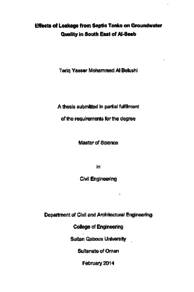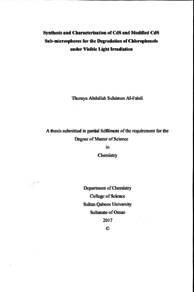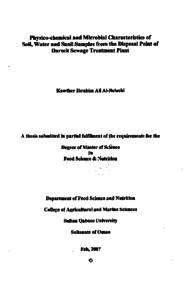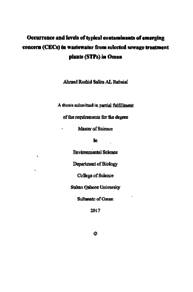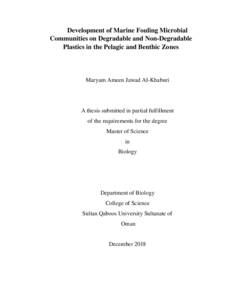Document
Effects of leakage from septic tanks on groundwater quality in south east of Al-Seeb
Publisher
Sultan Qaboos University
Gregorian
2014
Language
English
Subject
English abstract
Groundwater is one of the most valuable resources in Oman. Al-Seeb city is one of the most cities storing groundwater. The rapid residential activities took place during the last 15 to 20 years, especially in the South East of AlSeeb until it became one of the most congested cities across the country. The buildings have been designed and built with septic tanks as a basic sewage system. Many of these septic tanks are very old and outdated. Furthermore, many of them have not been built according to the required specifications, which resulted in the leakage of wastewater through the soil to the groundwater. This research study aims at studying the effects of septic tanks leakages on groundwater quality in south east of Al-Seeb area. Seven different drinking water wells have been selected to evaluate the quality of the groundwater. The results were compared with the drinking water standard's. Five visits were conducted to each well between February and October 2013. Samples were collected and analysed for different water quality to evaluate the risk on environment and public health due to wastewater leakages from the septic tanks. Tests include microbiological test, biochemical oxygen demand (BOD), pH, electrical conductivity (EC), turbidity, alkalinity, hardness, total organic carbon (TOC), anions (Fluoride, Chloride, Bromide, Nitrate, Sulphate), and cations (Sodium, Potassium).. The obtained results showed elevated values of specific tests such microbial test (coliform bacteria reached 200 MPN per 100 ml in some cases), BOD (reached 10 mg/l in some cases), TOC (reached 100 mg/l in some cases) and nitrate (exceeded 100 mg/l in some cases) indicated possible contamination due to wastewater. However, this problem needs more detailed studies to collect sufficient data to reach solid conclusions. Consequently, appropriate recommendations and action plans can be taken to prevent and alleviate this long term problem.
Member of
Resource URL
Arabic abstract
تعد المياه عصب الحياة على وجه الأرض والمياه الجوفية هي واحدة من أثمن الموارد الطبيعية للمياه في سلطنة عمان. وتعتبر ولاية السيب واحدة من أكثر المدن تخزينا لمصادر المياه الجوفية في السلطنة. إلا أن ولاية السيب شهدت نموا متسارعا في النشاط السكاني على مر العقدين الماضيين، وخاصة في جنوب شرق هذه الولاية حتى أصبحت واحدة من أكثر المدن ازدحاما في السلطنة. ولعدم وجود شبكة صرف صحي في الولاية فقد تم تصميم المباني في هذه المدينة بحيت تحتوي على خزانات التجميع مياه الصرف الصحي تحت الأرض، إلا أن كثيرا من هذه الخزانات تقادم عليها الزمن وأخرى لم يتم بنائها وفقا للمواصفات المطلوبة مما أدى إلى تسرب مياه الصرف الصحي عبر طبقات الأرض مما قد يسهم في تلوث المياه الجوفية تقوم هذه الدراسة على محاولة تقييم تأثير تسرب مياه الصرف الصحي من هذه الخزانات إلى باطن الأرض وتحديدا إلى المياه الجوفية، حيث تم اختيار سبعة آبار مختلفة لمياه الشرب في عدة منازل بالسيب وتحليل جودة مياها للاستخدام البلدي ودراسة مدى تأثرها بتسرب المياه العادمة من خزانات الصرف الصحي. وقد تم تقييم عدة عوامل فيزيائية وكيمائية وبيولوجية: البكتريا القولونية ومعامل الأكسجين البيوكيميائي ودرجة الحموضة ومعدل الملوحة والعكارة وقلوية وعسر الماء مجموع الكربون العضوي والأيونات السالبة والموجبة.. وقد تم أخذ العينات لعدة شهور في السنة من فبراير إلى أكتوبر 2013. واظهرت النتائج وجود تلوث بيولوجي (بكتيريا قولونية) وعضوي (معامل الأكسجين البيوكيميائي و مجموع الكربون العضوي) وكيميائي (نترات) مرتبط بالمياه العادمة، مما يؤشر إلى تسرب مياه الصرف الصحي من الخزانات إلى المياه الجوفية. ولكن تبقى الحاجة إلى القيام بدراسة شاملة لتغطي مساحة أكبر مناطق سكنية متعددة) ولفترة زمنية مناسبة (سنتين إلى ثلاث سنوات حتى يتسنى الجزم بمصدر هذه الملوثات. وذلك للوصول إلى توصيات وحلول مناسبة لهذه المشكلة على المدى البعيد.
Category
Theses and Dissertations

